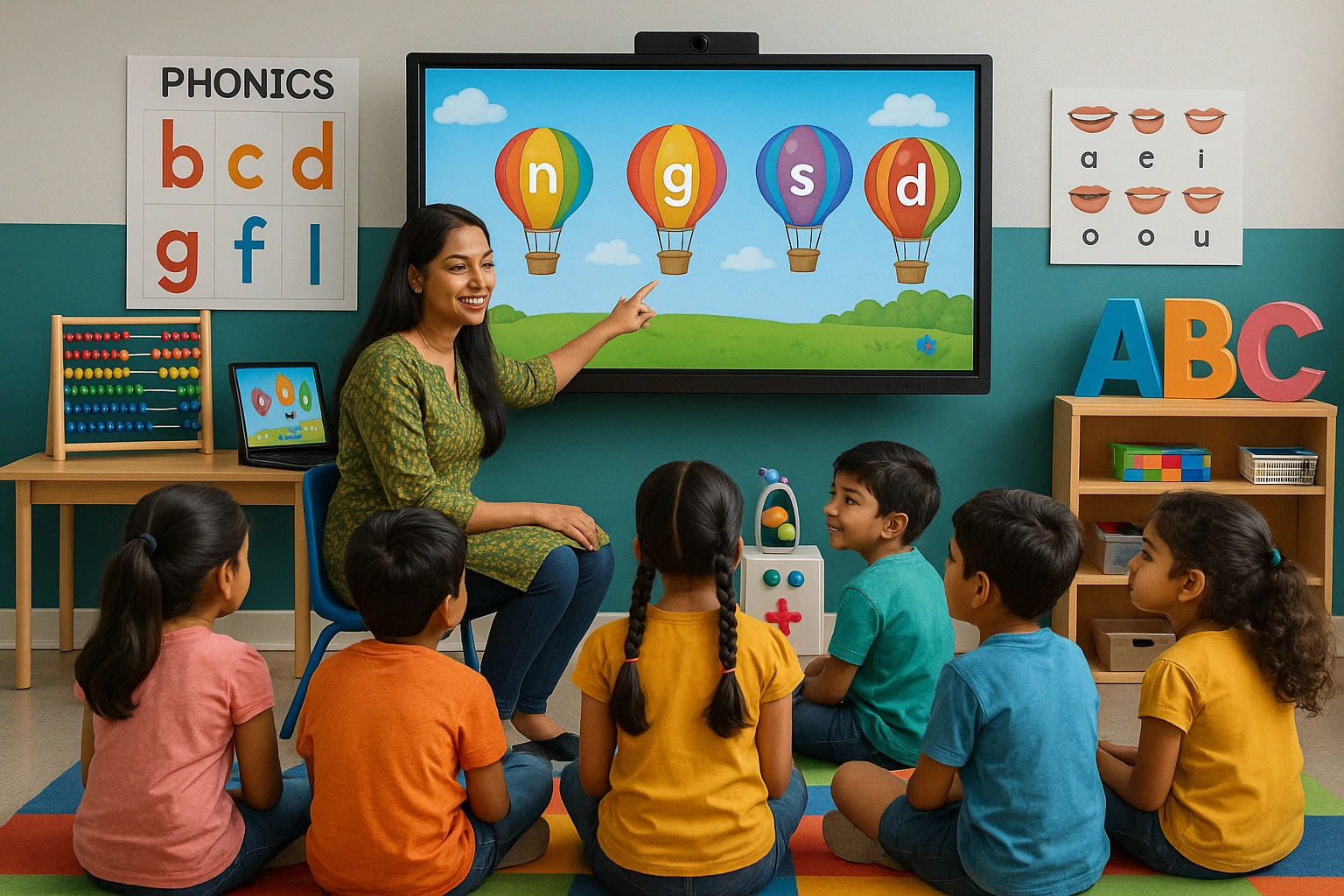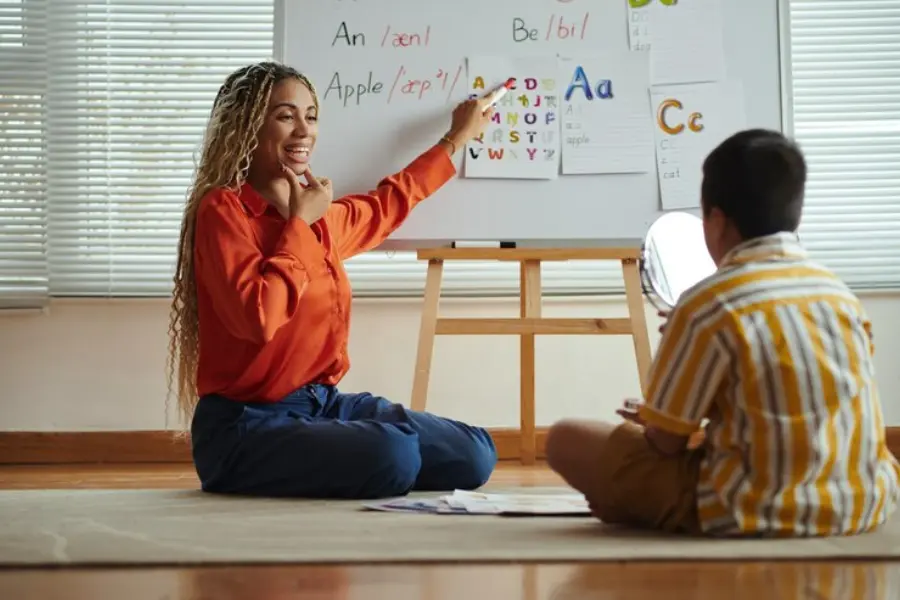Which is the Best Way to Teach Phonics to Preschooler?
Source: landmarkschool
Which is the Best Way to Teach Phonics to Preschooler?
Teaching Phonics to Preschoolers helps them grow into confident readers. With so many methods available, it can be puzzling to figure out which one truly fits best for young learners. Deciding the right Way to Teach Phonics to Preschoolers can make a huge difference in how effortlessly they associate sounds with letters and words. In this blog, we’ll explore various strategies and help you find the most effective Way to Teach Phonics to Preschoolers and make learning fun and interesting.
Table of Content
What are the Steps to Teach Phonics Effectively?
Splitting the process into clear, simple steps that build on each other is the Best Way to Teach Phonics to Preschoolers. Preschoolers learn best when lessons are interesting, hands-on, and repeated in significant ways.
Here are the key Steps to Teach Phonics Effectively:
Introduce the Sound
Start with one sound at a time. Use visual learning resources, such as pictures or flashcards, to help children acknowledge the sound, especially when teaching digraphs.
Associate and Pronounce
Connect the sound with the letter or letters that represent it. Say the sound clearly and encourage children to repeat it aloud. Use everyday words to help them understand how the sound is used.
Engross with Activities
Use games, songs, and hands-on materials to keep learning fun and memorable. Activities like matching games or sound hunts help reinforce what they’ve learned.
Apply in Reading
Let children hear and find the sounds in simple books. As you read together, point out the letters and ask them to identify the sounds.
Introduce Phonemic Awareness
Assist children in interpreting how sounds work in words. Arrange practice sessions and let them identify the beginning, middle, and ending sounds, and ask them to split words into their discrete sounds.
Teach Letter Sounds
Teach each letter’s sound before its name. Focus on lowercase letters first, since they appear more often in print.
Blend Sounds
Once children know a few sounds, show them how to blend those sounds together to form simple CVC words (cat, dog, hat, etc.).
Concentrate on Word Families
Put similar-sounding words in one group, like bat, cat, mat, etc. This helps children understand word patterns and build confidence as they begin to read more on their own.
These steps provide the right Way to Teach Phonics to Preschoolers and their thoughtful and consistent use can help children develop a strong foundation in phonics and gain the means they need to become fluent readers.

What are Helping Tools to Teach Phonics?
Pairing instruction methods with the right tools is the Best Way to Teach Phonics to Preschoolers as it makes learning interactive and enjoyable. For Indian students, integrating visual resources, playful activities, and hands-on learning can help build a strong foundation in letter-sound association, blending, and segmenting.
Here are some Helping Tools to Teach Phonics that support learning in a fun and structured way:
Visual Aids & Materials:
Flashcards
Use picture flashcards with matching words to help children associate letters with their respective sounds.
Posters
Display colorful posters of the alphabet, phonics sounds, and common word patterns to make a phonics-rich environment.
Bookmarks
Provide students with phonics bookmarks showing key sounds or word families for quick reference and review.
Digital Flashcards
Use interactive phonics flashcards available on apps or websites for more dynamic learning.
Worksheets
Use worksheets to enhance skills like blending, segmenting, and recognizing specific sounds.
Engaging Activities & Games
Phonics Bingo
Create bingo cards with sounds, blends, or words. Call out sounds, and have children find the matching square.
Word Hunt
Hide words around the room or at home. Let kids search, read aloud, and match them to pictures or sounds.
Rhyming Games
Play games that challenge students to find words that rhyme. This strengthens sound recognition.
Songs & Rhymes
Use catchy songs and rhymes that repeat phonics sounds and word patterns. Repetition through music helps with memory.
Jingles & Actions
Pair phonics jingles with simple hand motions or gestures to reinforce learning through movement.
Decodable Books
Choose books that are specifically designed to align with the sounds students are learning. These books help build reading confidence.
Blending and Segmenting Activities
Practicing blending and segmenting improve phonics familiarity. Use objects or picture cards for better understanding.
Computer Games
Using online interactive phonics games to keep learners involved while reinforcing key concepts is another innovative Way to Teach Phonics to Preschoolers.
Multi-Sensory Methods
Use sandpaper letters, magnetic letters, or clay to let children sense and shape letters as they articulate the sounds, engaging touch, sight, and sound.
Using a combination of these tools is the right Way to Teach Phonics to Preschoolers making learning effective, engaging, and appropriate for diverse learning styles.

Source: freepik
Why Phonics Teaching is an Exciting Opportunity?
Phonics Teaching helps young minds understand the word structure. Vidhyanidhi Education Society (Govt. Regd.) offers a Phonics Teacher Training Course that equips educators and parents with the right Way to Teach Phonics to Preschoolers and make early reading both effective and fun. With an increasing need for phonics-based education in schools and at home, this course offers a significant prospect to build a robust foundation for children while unlocking new doorways for professional advancement.
Let us see Why Phonics Teaching is an Exciting Opportunity:
Benefits Develop Early Literacy Skills
Phonics lets children associate sounds with letters, thus helping them become independent readers. Teaching these skills gives you a direct role in their literary success.
Creative and Fun Approach
Teaching phonics involves rhymes, games, narratives, visual tools, etc., making every session active and engaging—for both the teacher and the learner.
High Demand in Schools and Learning Centers
With more schools acknowledging the significance of phonics, trained phonics teachers are in demand. Completing a Phonics Teacher Training Course boosts the value of your resume and unlocks new doors to teaching possibilities.
Ideal for Parents and Tutors
Parents who want to teach their children at home can benefit greatly from the Phonics Teacher Training Course. It gives them the right techniques to make learning enjoyable and effective.
Flexible Career Option
Whether you’re looking for a full-time career or a part-time job from home, the aptitudes from the Phonics Teacher Training Course can help you understand the ideal Way to Teach Phonics to Preschoolers and give you the confidence to teach small groups, establish classes, undertake private sessions.
The perfect Way to Teach Phonics to Preschoolers does not revolve only around letters and sounds—it’s about using approaches to build confidence in young learners. With the assistance of Vidhyanidhi Education Society’s (Govt. Regd.) Phonics Teacher Training Course, you can start making a difference while enjoying a fulfilling teaching experience.
Master Vidhyanidhi Education Society’s (Govt. Regd.) Best Phonics Teacher Course! Enrol today and excel in phonics!
For details of Best Phonics Teacher Course, Call / Whatsapp on +919869866277 / +919869546913.
Click Here, to download Best Phonics Teacher Course brochure!
FAQs
At what age do Children Learn Phonics?
Children usually start learning phonics around age 3 to 4, when they begin preschool or nursery, focusing on letter sounds and simple word structure.
How to Teach Phonics to Preschoolers?
Start with letter sounds, use songs, rhymes, and flashcards. Vidhyanidhi Education Society’s Phonics Course helps make learning structured and fun.





